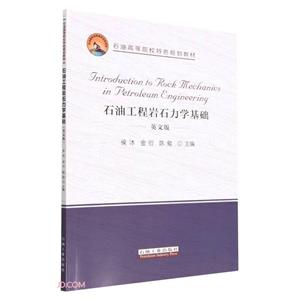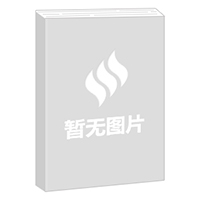掃一掃
關注中圖網
官方微博
本類五星書更多>
-
>
公路車寶典(ZINN的公路車維修與保養秘籍)
-
>
晶體管電路設計(下)
-
>
基于個性化設計策略的智能交通系統關鍵技術
-
>
花樣百出:貴州少數民族圖案填色
-
>
山東教育出版社有限公司技術轉移與技術創新歷史叢書中國高等技術教育的蘇化(1949—1961)以北京地區為中心
-
>
鐵路機車概要.交流傳動內燃.電力機車
-
>
利維坦的道德困境:早期現代政治哲學的問題與脈絡
買過本商品的人還買了
石油工程巖石力學基礎 版權信息
- ISBN:9787518355907
- 條形碼:9787518355907 ; 978-7-5183-5590-7
- 裝幀:一般膠版紙
- 冊數:暫無
- 重量:暫無
- 所屬分類:>
石油工程巖石力學基礎 內容簡介
本書以巖石的力學性質、強度理論和破壞準則為基礎,通過對現場油田應力和井筒圍巖應力狀態的分析,系統闡述了井筒穩定性、水力、壓裂、出砂等石油工程中的基本巖石力學問題,以及地球物理資料的應用。 本書可作為石油工程、油氣儲運工程、海洋油氣工程、地質工程、地球物理勘探等專業的本科、研究生教材。也可供鉆井、采油、地質、測井等技術人員參考。
石油工程巖石力學基礎 目錄
Chapter 1 Introduction
1.1 Overview of Rock Mechanics
1.2 History of Rock Mechanics
1.3 Research Methods of Rock Mechanics
1.4 Research Objects and Characteristics of Rock Mechanics in Petroleum Engineering
Questions
Chapter 2 Mechanical Properties and Deformation Characteristics of Rocks
2.1 Mechanical Properties of Rocks
2.2 Rock Uniaxial Compression Test
2.3 Rock Triaxial Compression Test
2.4 Tensile Fracture Test of Rock
2.5 Rock Creep and Its Mechanism
Questions
Chapter 3 Theory of Rock Strength
3.1 Mohr-Coulomb Criterion
3.2 Drucker Prager Criterion
3.3 Griffith Criterion
3.4 Murrel Extension of Griffith Criterion
Questions
Chapter 4 Fluid Pressure and Flow in Rock
4.1 Porosity and Permeability of Rock
4.2 Fluid Flow in Pores
4.3 Commonly Used Petrophysical Models
4.4 One-dimensional Consolidation
4.5 Effective Stress in Rocks
Questions
Chapter 5 Oil Field In-situ Stress and Stress State of Surrounding Rock of Borehole Wall
5.1 Pore Pressure
5.2 In-situ Stress Analysis of Oilfield
5.3 Stress Distribution of Vertical Wellbore
5.4 Stress Distribution of Confining Rock in Horizontal Well and High Angle Deviated Well
5.5 Method to Confirm Oilfield In-situ Stress
5.6 Prediction Model of Oilfield In-situ Stress
Questions
Chapter 6 Wellbore Collapse and Diameter Reduction
6.1 Wellbore Collapse
6.2 Under Gauge of Borehole in Plastic Formations
6.3 Wellbore Deformation in Viscoelastic Formation
6.4 Critical Collapse Time of Water-sensitive Shale Formation
Questions
Chapter 7 Borehole Collapse
7.1 Mechanical Mechanism of Vertical Borehole Wall Fracture
7.2 Engineering Prediction Model of Fracture Pressure
7.3 Shaft Wall Fracture in Highly Deviated Well
7.4 Drilling Fluid Density Window in Highly Deviated Wells
Questions
Chapter 8 Hydraulic Fracturing
8.1 Overview of Hydraulic Fracturing
8.2 Numerical Simulation of Hydraulic Fracturing
8.3 Small-scale Fracturing
8.4 Hydraulic Fracturing Physical Simulation
Questions
Chapter 9 Sand Production from Oil and Gas Wells
9.1 Overview of Sand Production in Oil and Gas Wells
9.2 Models of Sand Arch
9.3 Common Prediction Methods of Sand Production Engineering
9.4 Sand Control Methods and Their Selection
Questions
Chapter 10 Application of Acoustic Logging and Seismic Data to Rock Mechanics
10.1 P-wave and S-wave in Elastic Media
10.2 Determination of Rock Elastic and Strength Parameters by Acoustic Logging
10.3 Three Pressures Determination Using Acoustic Logs
10.4 Engineering Prediction Theory of Seismic Data
Questions
References
1.1 Overview of Rock Mechanics
1.2 History of Rock Mechanics
1.3 Research Methods of Rock Mechanics
1.4 Research Objects and Characteristics of Rock Mechanics in Petroleum Engineering
Questions
Chapter 2 Mechanical Properties and Deformation Characteristics of Rocks
2.1 Mechanical Properties of Rocks
2.2 Rock Uniaxial Compression Test
2.3 Rock Triaxial Compression Test
2.4 Tensile Fracture Test of Rock
2.5 Rock Creep and Its Mechanism
Questions
Chapter 3 Theory of Rock Strength
3.1 Mohr-Coulomb Criterion
3.2 Drucker Prager Criterion
3.3 Griffith Criterion
3.4 Murrel Extension of Griffith Criterion
Questions
Chapter 4 Fluid Pressure and Flow in Rock
4.1 Porosity and Permeability of Rock
4.2 Fluid Flow in Pores
4.3 Commonly Used Petrophysical Models
4.4 One-dimensional Consolidation
4.5 Effective Stress in Rocks
Questions
Chapter 5 Oil Field In-situ Stress and Stress State of Surrounding Rock of Borehole Wall
5.1 Pore Pressure
5.2 In-situ Stress Analysis of Oilfield
5.3 Stress Distribution of Vertical Wellbore
5.4 Stress Distribution of Confining Rock in Horizontal Well and High Angle Deviated Well
5.5 Method to Confirm Oilfield In-situ Stress
5.6 Prediction Model of Oilfield In-situ Stress
Questions
Chapter 6 Wellbore Collapse and Diameter Reduction
6.1 Wellbore Collapse
6.2 Under Gauge of Borehole in Plastic Formations
6.3 Wellbore Deformation in Viscoelastic Formation
6.4 Critical Collapse Time of Water-sensitive Shale Formation
Questions
Chapter 7 Borehole Collapse
7.1 Mechanical Mechanism of Vertical Borehole Wall Fracture
7.2 Engineering Prediction Model of Fracture Pressure
7.3 Shaft Wall Fracture in Highly Deviated Well
7.4 Drilling Fluid Density Window in Highly Deviated Wells
Questions
Chapter 8 Hydraulic Fracturing
8.1 Overview of Hydraulic Fracturing
8.2 Numerical Simulation of Hydraulic Fracturing
8.3 Small-scale Fracturing
8.4 Hydraulic Fracturing Physical Simulation
Questions
Chapter 9 Sand Production from Oil and Gas Wells
9.1 Overview of Sand Production in Oil and Gas Wells
9.2 Models of Sand Arch
9.3 Common Prediction Methods of Sand Production Engineering
9.4 Sand Control Methods and Their Selection
Questions
Chapter 10 Application of Acoustic Logging and Seismic Data to Rock Mechanics
10.1 P-wave and S-wave in Elastic Media
10.2 Determination of Rock Elastic and Strength Parameters by Acoustic Logging
10.3 Three Pressures Determination Using Acoustic Logs
10.4 Engineering Prediction Theory of Seismic Data
Questions
References
展開全部
書友推薦
- >
詩經-先民的歌唱
- >
伯納黛特,你要去哪(2021新版)
- >
隨園食單
- >
我與地壇
- >
月亮虎
- >
大紅狗在馬戲團-大紅狗克里弗-助人
- >
朝聞道
- >
回憶愛瑪儂
本類暢銷

















